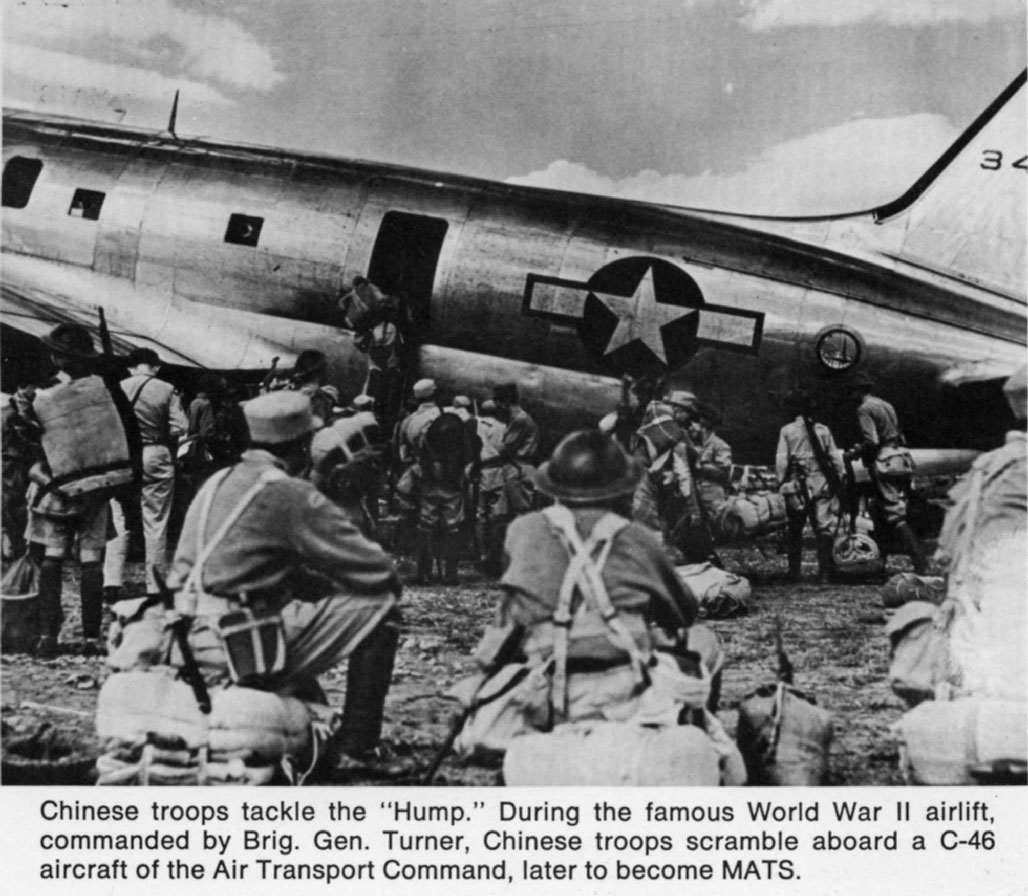
MATS' predecessors, the ATC (Air Transport Command) and NATS (Naval Air Transport Service), were born of necessity when the United States entered World War II. In December, 1941, the Army Air Corps Ferrying Command, which shortly became the ATC, had only eleven crudely converted B-24 Consolidated Liberator bombers, some eleven Boeing Clippers and Martin Flying Boats which the Air Corps had purchased from Pan American Airlines, and five TWA Boeing Stratoliners.
From this humble beginning the ATC grew to the point where it was able to schedule twenty-six daily flights each way across the Atlantic Ocean and thirty-eight over the Pacific - as well as numerous flights from India to China, and back - over the "Hump."

From a few men, it grew to a force of a quarter of a million with 3,000 cargo aircraft. And, like "Topsy," it grew more by happenstance than by design. By VE-day ATC routes covered the world, touched every continent, and virtually spanned every sea and ocean. And this did not include the NATS' 70,000 miles of routes serviced by over 430 naval transport aircraft.
One of the most dramatic accomplishments of the ATC was flying the "Hump" - the high Himalaya mountain range between China and India. This was a case of "the difficult we do today, the impossible - tomorrow." But in ATC's case, it did the impossible "today"!
In December of 1942, after the Japanese had cut off the Burma Road, the Air Transport Command took over the responsibility of supplying China from India. Although a number of their aircraft and supplies had been "pirated" by other unsympathetic commands, they still had a job to do. The goal of the ATC's India-China Wing was to deliver 2,500 tons during the month of February and to double that tonnage shortly thereafter. The ATC succeeded in making their quotas and, near the end of the war in July, 1945, were able to deliver the amazing total of more than 71,000 tons of cargo to China for that month.
This they did by flying the 520 miles directly from the broiling sun of Assam, India, over steaming, fetid jungles infested with unfriendly headhunting tribes; wild animals, snakes, and insects; poison and disease; and enemy-held territory where Japanese patrols tried to lead them astray with false beacons. It was a flight that took them over the world's highest, most treacherous mountain range - to the rough, hand-hewn runways at Kunming, painstakingly laid out by countless thousands of Chinese coolies. And often, after these intrepid ATC pilots had completed their treacherous journey, they found that the landing field was underwater and/or closed in by clouds.
Many times the pilots took the less direct route, farther to the northwest, flying an additional 200 miles to avoid the enemy-held territory. They crossed the Hump at from 16,000 to 18,000 feet. In bad weather, however, the minimum was 20,000 feet, at which altitude the wings and control surfaces iced up.
All of this was accomplished despite the annual eight months of torrential, tropical downpours known as monsoons, which are followed by four months of violent, turbulent windstorms, capable in extremes of lifting or dropping a plane 6,000 to 8,000 feet in a minute. To top it all, these missions were flown by crews suffering from malaria and dysentery. (It was estimated officially that less than 60 per cent of the personnel would be effective after a year, and less than 30 per cent, six months later.) However, even if the weather happened to be good, and by some chance the crew happened to be in good health, the unarmed cargo planes - the C-46 Curtiss Commando and the Douglas C-47 affectionately known as the "Gooney Bird" - were still vulnerable to attack from Jap Zero fighter planes.
Through all of these trials and sufferings, the hard-pressed India-China Wing was successively commanded by Generals Alexander, Hoag, and Tunner. The last, Gen. William H. Tunner, stressed safety and efficiency and made the Hump operation the greatest airlift in history - up to that time. He later topped his own record in commanding the famous Berlin Airlift and the supplying of the United Nations Forces in the Korean conflict. General Tunner succeeded to the overall command of MATS from 1958 to i960.

Together with Hannibal's crossing of the Alps, the Hump operation will go down in the annals of military history as one of the most difficult logistic missions accomplished by any military force. Their task was nobly done, defying all reason and common sense, and it was accomplished by dint of sheer willpower alone.
During those bleak days of the war, any ATC crewmen who had flown the Hump could hold their heads high in the face of the friendly jibes from fighter and bomber combat crews. In fun, their tormentors swore that the initials ATC stood for Allergic To Combat and in good humor they sang, "Take down your service flag, Mother. Your son's in the ATC."
In the beginning there had been very few who believed that the job could be done. Even the Japanese High Command refused to consider them a threat, doubting that they could even lift 1,000 tons a month to China. But the Army Air Corps' Air Transport Command had done it - and a lot more besides.